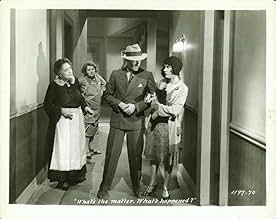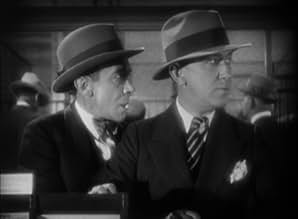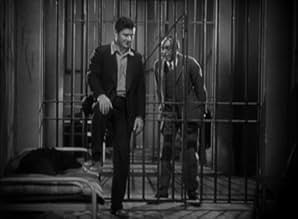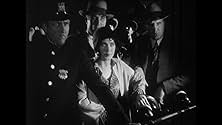Añade un argumento en tu idiomaA criminal known as Thunderbolt is imprisoned and facing execution. Into the next cell is placed Bob Moran, an innocent man who has been framed and who is in love with Thunderbolt's girl. Th... Leer todoA criminal known as Thunderbolt is imprisoned and facing execution. Into the next cell is placed Bob Moran, an innocent man who has been framed and who is in love with Thunderbolt's girl. Thunderbolt hopes to stave off the execution long enough to kill young Moran for romancing h... Leer todoA criminal known as Thunderbolt is imprisoned and facing execution. Into the next cell is placed Bob Moran, an innocent man who has been framed and who is in love with Thunderbolt's girl. Thunderbolt hopes to stave off the execution long enough to kill young Moran for romancing his girl.
- Dirección
- Guión
- Reparto principal
- Nominado para 1 premio Óscar
- 2 premios y 1 nominación en total
- Thug in Bank at Robbery
- (sin acreditar)
- Prisoner #8
- (sin acreditar)
- Black Cat Cafe Patron
- (sin acreditar)
- Chuck - 1st Prisoner #5
- (sin acreditar)
Reseñas destacadas
Mankiewicz's famous telegram to Ben Hecht describes how desperate movie studios were to hire good writers. "Millions are to be grabbed out here and your only competition is idiots. Don't let this get around."
Mankiewicz was the highest-paid writer in Tinseltown. Kael described, "His heroes weren't soft-eyed and bucolic; he brought good-humored toughness to the movies, and energy and astringency. And the public responded, because it was eager for modern American subjects." In "Thunderbolt," adapted from a Charles and Jules Furthman story, Mankiewicz's script focuses on Jim Lang (George Bancroft), nicknamed Thunderbolt, wanted by the police. His girlfriend, 'Ritzy' (Fay Wray), is seeing banker Bob Moran (Richard Arlen) behind Jim's back. Lang is captured and is headed for the chair. In jail, he discovers who Ritzy's boyfriend is and frames Bob in a cop's murder. When arrested and sentenced, Bob finds himself in the jail cell next to Thunderbolt.
"Thunderbolt" was the type of movie designed for director Josef von Sternberg for his first talkie. The silent movie director of 1927's "Underworld," which introduced the gangster genre, was excited to be making talkies. He said he was "no longer at the mercy of movie house organists."
Sternberg especially loved to mix music with his actors' dialogue. In a classic nightclub scene, singer actress Theresa Harris, in her film debut, belts out a song while Thunderbolt and Ritzy are in an argument. Between Harris' numbers, the jazz band plays in the background while tension builds between Lang and nearby loud customers. The tense sequence reveals the inner turmoil of Thunderbolt. Film critic Andrew Sarris notes, "'Thunderbolt' is, in some respects, as much a musical as a melodrama." Sternberg was praised overseas for his film, receiving a telegram from German director Ludwig Berger, stating "I saw your film 'Thunderbolt' and congratulate you with all my heart. It is the first fully realized and artistically accomplished sound film. Bravo!" "Thunderbolt" was the second talkie for actor George Bancroft, his first was the now lost 1929 'The Wolf of Wall Street.' The actor earned a Best Actor Academy Award nomination for his role as Thunderbolt.
The future was bright for Mankiewicz, working alongside his younger brother, Joseph, who wrote the titles in "Thunderbolt." Herman is known by today's movie fans as the first screenwriter for 1939's "The Wizard of Oz," and for his collaboration with Orson Welles in 1941's "Citizen Kane."
Even the music, and the way it was edited between scenes, left a lot to be desired. It sounded like the music from one room stopped abruptly when they would go to another room. Besides the sound, the characters were hard to take seriously. I can't really speak on anything else, because the poor audio truly did ruin any investment I could have in this story, and the film as a whole.
If I'm being honest, there really isn't much of a point in posting this review besides letting other people know, trust me, if you can't sit through this, you're not alone. It's not because it's too old. There are plenty of great films from the 20s. Watch Chaplin, watch Keaton, watch Metropolis, watch Sunrise, watch The Crowd, watch Lonesome. Watch almost anything else but this one...
This isn't a gangster film, it's an intelligently written character study and in-depth look into the mind of a mobster. You find writer Jules Furthman's name on virtually every other classic Hollywood picture of the 20s, 30s and 40s. His style was quality and his skill was creating believable engaging stories with real genuine characters. His story was further adapted by H Mankiewicz - who wrote the scripts for the probably the other half of the classics from this period. Needless to say - this is well written with fascinating and deeply faceted characters.
Josef von Sternberg directed this which by the look of it was his fiftieth talkie. Surely it's impossible that this was his first sound film? Being made in 1929, it's still a little experimental, not quite everything works so this is not one of his best pictures. Nevertheless he creates a brooding almost surreal atmosphere with real tension. That style intensifies significantly in the latter part of the film on death row which has an almost dream like feel about it.
The story is tense, the characters are believable, the production is innovative but this is not a perfect film. To enable clear sound recording, some but not all of the actors speak very slowly which sounds especially weird when the actor they're talking with is speaking normally. Actors had their own individual vocal coaches then with different techniques thus the inconsistency and maybe not being a native English speaker, von Sternberg probably didn't notice the subtle differences.
As great a director as he was, von Sternberg was given the impossible task of trying to make Fay Wray seem like a proper actress. Not even he could do that and predictably she's absolutely dreadful. As always she just projects that limp, whining and insipid expression to convey whatever emotion she's trying to express.
Whether she's pretending to be a hard as nails gangster's moll or a reformed, sweet and vulnerable fragile young thing she's that same bland, shallow character. Not only can't she act but in this she doesn't appear to be able to speak English - what on earth is that accent! She's meant to be a girl from the streets so why is she doing history's worst impression of Queen Mary? That two men could be besotted with this dull sour-faced non-entity completely stretches all credibility.
Bancroft is once again a gangster (as before, his activity remains undisclosed throughout, apart from lording it up in an almost exclusively-black nightclub!) and his moll eventually leaves him for another, younger and handsomer, man. Here, too, the mobster is caught and imprisoned – in a wonderful scene where he shows compassion for a mutt, subsequently proving inseparable, thus preceding Raoul Walsh's HIGH SIERRA by 12 years! Yet, he ingeniously has his associates frame the rival for a murder they committed (the development of this particular plot strand is unfortunately rather muddled) and the hero winds up in the cell opposite Bancroft's. As in UNDERWORLD, Fred Kohler also appears here to antagonize the latter – besides lanky warden Tully Marshall and an Irish guard whose name the protagonist continually tries to guess (with the droll pay-off coming at the film's very conclusion).
Wray and her mother plead with the gangster to do the right thing and clear Arlen of his crime but, of course, he will have none of that at the start. Again, however, Bancroft is softened and confesses his role in the young man's entrapment just hours before his execution is due; I have to wonder here why he, a first-time felon, is scheduled to die before the much sought-after "Thunderbolt"! – yes, the film's title is a reference to the character's nick-name. In any case, the moll's own admission that she had left her lover for the gangster rather than the other way around makes the latter realize, as was the case in UNDERWORLD, that he is in the way and gladly accepts his fate. Incidentally, speaking of references to the director's earlier work, Wray and Arlen are made to undergo a hasty marriage here – much like Bancroft himself and Betty Compson in THE DOCKS OF NEW YORK (1928)!
¿Sabías que...?
- CuriosidadesOne of the earliest of over 700 Paramount productions, filmed between 1929 and 1949, which were sold to MCA/Universal in 1958 for television distribution, and have been owned and controlled by MCA ever since. However, because of its extreme age, and primitive sound recording techniques, there is no record of it ever having been locally televised. On cable TV it received what may have been its first and only telecast on Turner Classic Movies in August 2016.
- Versiones alternativasMade in both sound and silent versions.
Selecciones populares
- How long is Thunderbolt?Con tecnología de Alexa
Detalles
- Duración1 hora 25 minutos
- Color


































